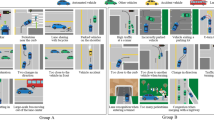Abstract
The human-machine interface is the main channel of human-vehicle communication in the process of human-machine co-driving. The display form of the interface information affects the driver's perception of the current driving status, which in turn generates a different state of trust. Therefore, this paper takes improving user's driving trust as the research basis and intelligent vehicle system interface information requirements as the research content, through users' subjective scoring of different driving trust levels presented by the interface information, the scored interface information is clustered and analyzed, and finally a driving trust-oriented intelligent system interface information priority design framework is constructed, which provides a theoretical reference and basis for solving the interface design of intelligent vehicle system for the purpose of trust calibration. It provides a theoretical reference and basis for solving the interface design of intelligent vehicle system for trust calibration.
Access this chapter
Tax calculation will be finalised at checkout
Purchases are for personal use only
Similar content being viewed by others
References
Gao, Z.L., Wenmin, L.J., et al.: Human-machine trust in self-driving vehicles. Adv. Psychol. Sci. 29(12), 2172–2183 (2021)
Hancock, P.A., Nourbakhsh, I., Stewart, J.: On the future of transportation in an era of automated and autonomous vehicles. Proc. Natl. Acad. Sci. 116(16), 7684–7691 (2019)
Detjen, H., Faltaous, S., Pfleging, B., et al.: How to increase automated vehicles’ acceptance through in-vehicle interaction design: a review. Int. J. Hum.-Comput. Interact. 2021(2), 1–23 (2021)
Monsaingeon, N., Caroux, L., Mougine, A., et al.: Impact of interface design on drivers’ behavior in partially automated cars: an on-road study. Transport. Res. F: Traffic Psychol. Behav. 81, 508–521 (2021)
de Visser, E.J., Cohen, M., Freedy, A., Parasuraman, R.: A design methodology for trust cue calibration in cognitive agents. In: Shumaker, R., Lackey, S. (eds) Virtual, Augmented and Mixed Reality. Designing and Developing Virtual and Augmented Environments. VAMR 2014. LNCS, vol. 8525, pp 251–262. Springer, Cham (2014). https://doi.org/10.1007/978-3-319-07458-0_24
Rodriguez, M.Z., et al.: Clustering algorithms: a comparative approach. PLoS ONE 14(1), e0210236 (2019)
Funding
Shanghai Pujiang Talent Program Project No. 21PJC032; National Natural Science Foundation of China Project No. 52205264.
Author information
Authors and Affiliations
Corresponding author
Editor information
Editors and Affiliations
Rights and permissions
Copyright information
© 2022 The Author(s), under exclusive license to Springer Nature Switzerland AG
About this paper
Cite this paper
Qi, G. (2022). Research on Information Design of Intelligent Vehicle System Interface Based on Driver Trust. In: Stephanidis, C., Antona, M., Ntoa, S., Salvendy, G. (eds) HCI International 2022 – Late Breaking Posters. HCII 2022. Communications in Computer and Information Science, vol 1655. Springer, Cham. https://doi.org/10.1007/978-3-031-19682-9_52
Download citation
DOI: https://doi.org/10.1007/978-3-031-19682-9_52
Published:
Publisher Name: Springer, Cham
Print ISBN: 978-3-031-19681-2
Online ISBN: 978-3-031-19682-9
eBook Packages: Computer ScienceComputer Science (R0)




